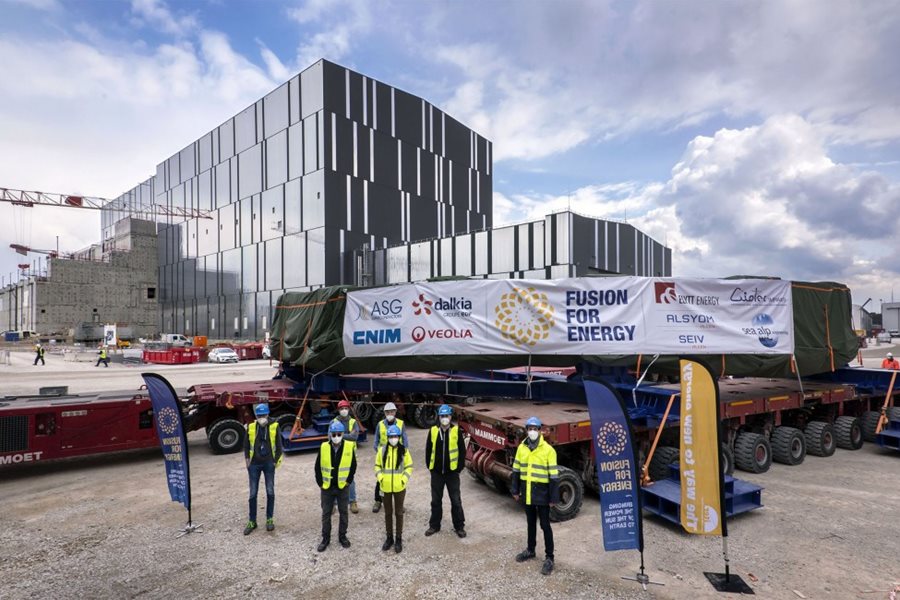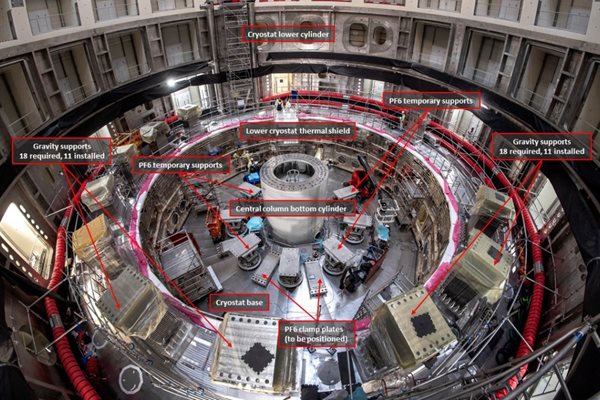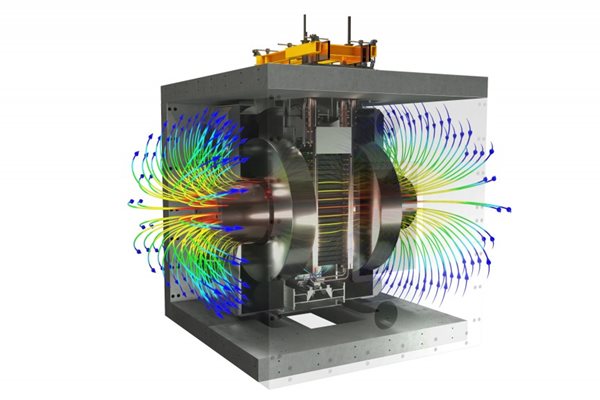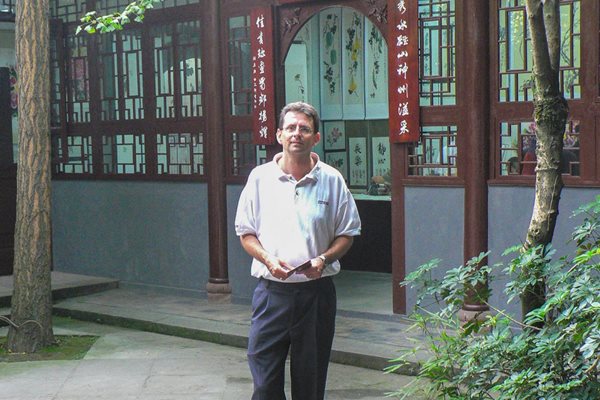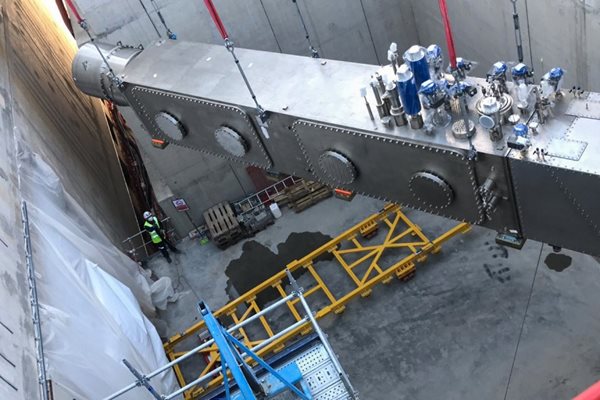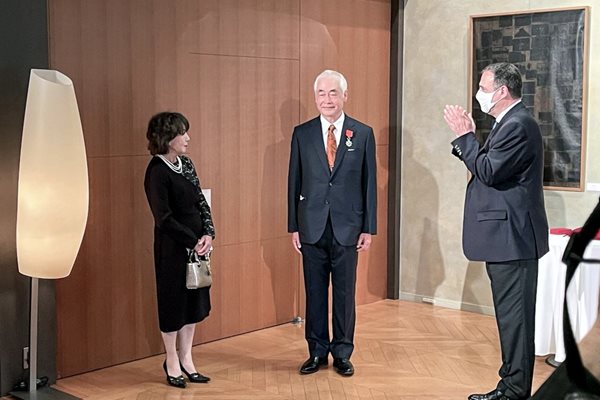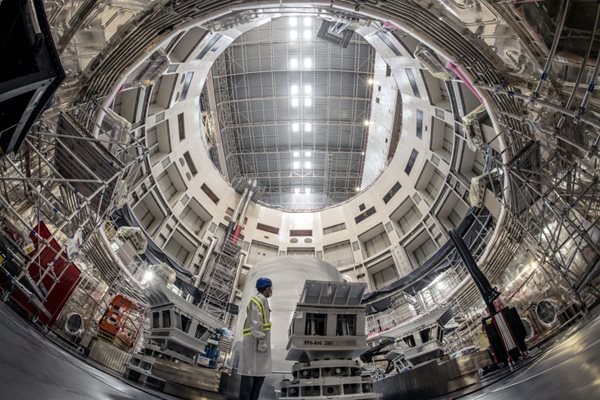
you're currently reading the news digest published from 12 Apr 2021 to 19 Apr 2021
featured7
press13
featured
European winding facility | First coil leaves production line
As long as a semi-trailer, nearly as heavy as a fully loaded Boeing 747, the first ITER ring magnet to be manufactured by Europe on site—poloidal field coil #5 (PF5)—has exited the building to await its turn for assembly in the Tokamak pit. It was grey and cold, but for the 20 people assembled it was a day that would not be easy to forget. The sight of the ring-shaped superconducting magnet emerging from the production facility where it had been more than three and a half years in the making was both historic and moving. For Alessandro Bonito-Oliva, the Magnets Programme Manager for the European Domestic Agency Fusion for Energy, this first coil produced entirely on site by European contractors served as an important learning curve for the three other coils to come (PF2, PF4 and PF3). 'We learned a lot, improved and developed techniques to overcome [...] technical difficulties along the way. Fusion for Energy supervised the entire production from the start, and with the valuable contribution of our contractors we delivered [the first poloidal field coil] made in Europe.' From the start of coil winding activities in September 2017, to resin impregnation, final assembly, and cold testing, the realization of PF5 was a meticulous, stage-by-stage process that required the expertise of a dozen companies and more than 150 people. A few days before the scheduled operation, three self-propelled modular transporters, piloted in sync, had entered the north end of the winding facility. Powered by 1000 HP hydraulic power packs and with the maneuverability of 36 axels and 144 wheels, the transporters passed under the coil frame and lifted the 340-tonne component (plus frame) off the ground. On Friday 16 April, the coil, protected under heavy-duty tarpaulin, was brought out of the coil building and delivered around the corner to a temporary storage tent. Now officially handed over to the ITER Organization, ring coil PF5 will wait its turn in the machine assembly sequence. See a full report on the Fusion for Energy website.
Inside the pit | From dizzying volume to cramped environment
There was a time when the assembly pit felt like a huge arena, with toy-like tools scattered on the floor and workers reduced to Playmobil-size figures. Progressively, over the past year, the perception has changed dramatically. As successive components are installed, the place seems to be shrinking—a dizzying volume turning into a cramped environment. In a spectacular operation, the 1,250-tonne cryostat base was first to enter the pit in May 2020. Resting on a set of 18 chrome-plated spherical bearings anchored in the massive concrete crown, the soup-dish-shaped component reduced the visible diameter of the pit by more than one metre but without altering the feeling of space. The pit still felt big and empty. The installation of the lower cylinder, the following August, and of the silver-plated lower cryostat thermal shield in January of 2021, also did not change this perception. Beginning in February, when the first gravity supports for the 18 toroidal field coils were installed on the base pedestal and the temporary supports for poloidal field coil #6 (PF6) were arranged in a circle in the centre of the pit, the place began to feel small and crowded. And when the bottom cylinder of the central column (the first segment of a 20-metre-tall assembly tool) was lowered into the pit on 27 March, it was as if the vast arena had shrunk to the dimensions of a small outdoor swimming pool—with room for a very limited number of swimmers. The present view, as reflected in this image, will soon be a thing of the past as PF6 (10 metres in diameter) is inserted this week. Enjoy it while it lasts ...
Fusion world | UKAEA's CHIMERA set to transform fusion component testing
Construction of a unique testing machine for fusion components is underway at the UK Atomic Energy Authority (UKAEA). The machine, known as CHIMERA (or Combined Heating and Magnetic Research Apparatus), will be located at UKAEA's new Fusion Technology Facility in South Yorkshire, UK. When it opens in 2022, CHIMERA will be the only device in the world able to subject critical fusion component prototypes to the combination of high heat flux with static and pulsed magnetic fields within a vacuum or inert atmosphere—conditions that will be faced in large fusion devices such as ITER and in future commercial plants. (Watch an animation here.) Key fusion in-vessel components like the blanket, divertor and diagnostic modules are expected to be tested. Optical digital image correlation and laser metrology will be used to map 3D surface deformations and damage due to the harsh testing environment. In addition to providing invaluable test results, these and other techniques will be used to generate and synchronize component digital twins—predictive models and simulations that will be crucial to the design and qualification of fusion power plants. This 'virtual qualification' is a key strand of CHIMERA's capability that will enable virtual testing of components under conditions that cannot be recreated in an experiment. 'This will enable a step change in our ability to verify and test components for all UK and international fusion research programs. It therefore represents a hugely important national capability, enabling industry in the UK and internationally to design, and eventually qualify, components for future commercial fusion power plants.' See the original article here. To learn more about the facility's capabilities or to express an interest in using CHIMERA visit this page or contact UKAEA Business Development Manager, John Steele, at john.steele@ukaea.uk.
Award | A 30-year friendship with China
Some thirty years ago, HT-7, China's first superconducting tokamak, was entering operation and experiencing some issues with its ion cyclotron resonance (ICRH) antenna. As the fusion world was already one tight-knit family, the European Commission dispatched a young plasma physicist to Hefei, in Anhui province, where the Institute of Plasma Physics of the Chinese Academy of Sciences (ASIPP) operated the machine. For Alain Bécoulet, current head of ITER engineering (and former head of France's Institute for Magnetic Fusion Research, IRFM, which operates the WEST project), the mission¹ opened a new chapter in his life, marked by multifaceted collaborations, international agreements and, above all, long-lasting personal friendships. In the Anhui province, friendships that are particularly meaningful are honoured by a special distinction, the "Huangshan Friendship Award.' Last week, it was bestowed on Bécoulet in recognition of his 30-year relationship with ASIPP and the part he played in the development of scientific collaborations between the Chinese and European fusion communities. For Bécoulet, who received another Chinese distinction earlier this year (the Scientific and Technological Cooperation Award of the People's Republic of China), the Friendship medal holds a special value. 'It's not just about the formal collaborations we have established between Chinese institutions and the WEST tokamak, or the Sino-French agreement SIFFER, or the CEA-ASIPP partnership ... it is also, and maybe above all, the warm and confident relationships that we developed during these three decades.' In the early 1990s, when Bécoulet went to Hefei to lend a hand to his ASIPP colleagues, ITER was a four-partner project that China would not join before a full decade. But the seeds of understanding and collaboration were planted, and for the present ITER Engineering Domain Head this is a most precious asset. ¹Bécoulet was accompanied by Bertrand Beaumont, a radio frequency heating expert, now head of the ITER Ion Cyclotron section.
Tokamak assembly | Building the feeders, segment by segment
Through an opening in the Tritium Building just large enough to admit the 11-metre-long components, two magnet feeder segments were introduced this month into the lower basement of the Tokamak Complex. From there, they were transported approximately 180 metres on rollers to their reserved positions around the Tokamak. Like spokes around the hub of a wheel, 21 feeders will be installed in the lower basement level (B2) of the Tokamak Building—all directed toward the magnet systems at machine centre; another 10 will be installed above the machine at L3 level. (See the illustrations in this article.) Measuring 30 to 50 metres in length and composed of three distinct segments, feeders are complex components that distribute and recover cryogenic fluids at different temperatures and connect the magnets to their power supplies. Key subcomponents that are housed inside the magnet feeders include high temperature superconducting current leads, busbars, piping for cryogenic fluids, and the cables for diagnostics signals—all carefully insulated by an actively cooled thermal shield and a vacuum duct. Coil termination boxes are the feeder segments located farthest from the machine core, outside of the bioshield. Cryostat feedthroughs pass through the concrete bioshield and cryostat and into the vacuum environment. And in-cryostat feeders connect directly to the superconducting coils. Over five years (2019 to 2023) the Chinese Domestic Agency will deliver the fully instrumented segments and equipment required for 31 feeders—approximately 1,600 tonnes of material and 100 large components. The teams at ITER will install and assemble the feeders, and realize 300 magnet feeder joints (more on that tricky operation here). For now, though, the assembly teams are positioning the elements received from China around the Tokamak pit. Five have been lowered into the Tokamak Complex including two this month: the cryostat feedthrough for poloidal field coil #4 (PF4, installation complete); the cryostat feedthrough for toroidal field coils #12 and #13 (TF12-13, installation complete); the coil terminal box serving TF12-13 (ongoing); the coil termination box for PF4 (this month, ongoing); and a cryostat feedthrough for the structure cooling feeder (STR3), which will supply supercritical helium to the case cooling circuits and the inter-coil-structure cooling circuits of the toroidal field coils, the central solenoid structures, and the correction coils (this month, ongoing). The latest operations were carried out by the TAC1 assembly contractor CNPE under the careful supervision of Tingzhi Zhou, Chen-Yu Gung, and Giobatta Lanfranco from the In-Cryostat, Cryostat Thermal Shield, Auxiliaries Section. The first activity on feeder joints is planned for this summer after the completion of special process qualification by the contractor.
Fusion world | Highest French distinction for former ITER Director-General
Established in 1802 by Napoléon Bonaparte, then the First Consul of the young French Republic, the French Legion of Honour (Légion d'honneur) is the highest of the French orders of merit. It is awarded to persons of 'eminent merit,' whether civilian or military. The Grand Master of the Order is the President of the French Republic. Although destined primarily to French citizens, the Légion d'honneur can be awarded to foreign nationals for distinguished service to France or for having demonstrated an exceptional commitment to the values of the French Republic. On 13 April 2021, at the French Embassy in Tokyo, the order was solemnly bestowed upon Prof. Osamu Motojima by French Ambassador Philippe Setton. Prof. Osamu Motojima headed the ITER Organization from 2010 to 2015 and, in the Ambassador's words, 'demonstrated exceptional human qualities and organizational competence' in managing 'the gigantic task' of launching the construction of the ITER installation and the fabrication of components by participating members. 'This moment is the highest honour of my existence,' said Prof. Motojima in his response to the Ambassador. 'It is a token of the long and fruitful collaboration between France and Japan in the field of fusion research.' Newsline and the entire ITER community extend warm congratulations to the new Chevalier de la Légion d'Honneur.
Welding | Cryostat base and lower cylinder are now one
Procured by India, the ITER cryostat is composed of four sections: the base, the lower and upper cylinders, and the top lid. Once positioned inside the assembly pit, the different sections are welded together in order to form the perfectly leak-tight vacuum chamber that will act as a thermos, insulating the ultra-cold superconducting magnets from the outside environment. Protected in a sealed cocoon, the upper cylinder has been in storage on the platform since April 2020. The cryostat base was lowered into the pit in May 2020, followed by the lower cylinder in August. As for the top lid, its 12 segments are being assembled and welded in the Cryostat Workshop. The first in-pit welding operation—the welding of the lower cylinder to the cryostat base—began in October 2020 and lasted six months, including testing. Like all previous cryostat welding operations, it was performed by India's contractor MAN Energy Solutions (sub-contractor of cryostat segment manufacturer Larsen & Toubro). Following a first phase of root welding by way of a technique known as 'double operator' welding (one working from the inside, the other from the outside), nine specialists continued working simultaneously on the 90 metres of circumference, using more than 1.5 tonnes of filler material in the process. Distortion monitoring was performed on a regular basis by way of 50 metrology targets distributed on the inner surface of the components. 'Because of the heat that the welds generate, deformation inevitably occurs, but we have ways to minimize that. Margins are included by manufacturing design and throughout this six-month operation we were never outside tolerance,' says Vikas Dube, a mechanical engineer in ITER In-Cryostat, Cryostat Thermal Shield, Auxiliaries Section. A weld, however, is not considered final until it is tested. Beginning with visual inspection, the non-destructive examination process implements a series of tests ranging from the simple, like dye penetrant test examination, to the ultra-sophisticated like helium leak tests. The final check consists of a dimensional inspection that compares the data from the welded components to the data that was recorded before the start of welding, as well as to the requirements from the manufacturing drawings. There again, 'everything was within the limits,' says Vikas.
